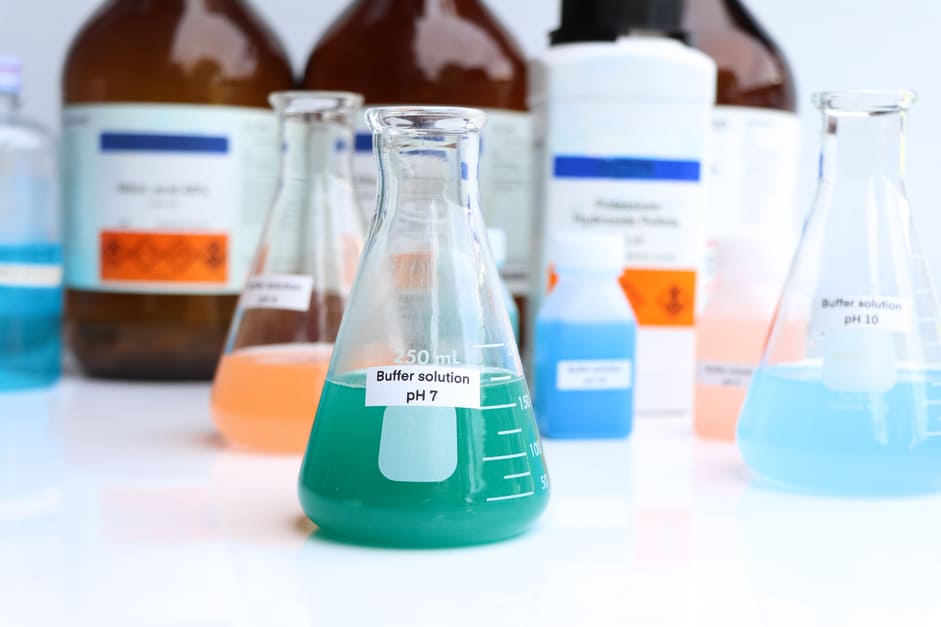The separation of charged biomolecules of a solution by their size and molecular weight is common for scientific studies and biomedical techniques for which various techniques of “electrophoresis” use an electric field, protein electrophoresis is among the widely used procedures.
The separation of protein analytes based on molecular weight by SDS-PAGE gel electrophoresis is the most common technique of protein electrophoresis for which a sample buffer – called laemmli buffer – is formulated. The Laemmli buffer was invented by Prof. Ulrich K. Laemmli in the 1970s while trying to modify SDS-PAGE technique.
It is invariant in nearly all protocols however its composition has been discussed since the 70s and alternatives have been suggested. Nevertheless, the Laemmli-based solution is still used and sold by companies with minor differences.
Commonly used alternatives are Morris SDS-PAGE sample buffer (very similar composition) and Phosphate modification of Laemmli sample buffer. The latter is known to reduce unexpected protein cleavage, thanks to the better-buffering capacity of phosphate at used pH.
Applications of Laemmli Buffer
- The Laemmli Buffer is used as a sample preparation buffer for protein samples in SDS-PAGE, compatible with Tris-glycine-SDS running buffer;
- It is used to reduce disulfide bonds for proteins denaturation and sample preparation to be used in the SDS-PAGE technique;
- It is used as an electrophoretic indicator dye for denaturation of proteins and monitoring the front of the running gel;
- It can be used for resuspension of Immunoprecipitation beads before SDS-PAGE;
- And it is also used for polyacrylamide protein gel analysis.
Components of Laemmli Buffer
It is composed of the 5 following reagents:
- Sodium dodecyl sulfate (SDS);
- A reducing agent: β-mercaptoethanol (BME) or Dithiothreitol (DTT);
- Tris-hydroxymethyl-aminomethane (Tris);
- Glycerol;
- A dye: bromophenol blue.
Role of reagents
1. Sodium dodecyl sulfate (SDS)
SDS is a negatively-charged detergent that non-covalently binds to all the proteins positive charges to denature them by disrupting non-covalent bonds to destabilize the secondary, tertiary, and quaternary structural assemblies (not all quaternary structural assemblies!!!). This masks proteins intrinsic charge and imparts to them a net negative charge so that they all separate based on size (i.e. molecular weight not charge or shape) and migrate in the same direction based on their charge during an SDS-PAGE experiment.
SDS molecule is an anionic surfactant due to the presence of negatively charged sulfate moieties. Adding SDS to Laemmli buffer causes repulsion among negatively-charged amino acids which in turn results in protein denaturation and linearizes all protein analytes.
This helps control their charge by adjusting the pH of the buffer they are exposed to, therefore during SDS-Page at pH 8.3 all sulfate moieties are deprotonated (negatively charged) and migrate toward anode when the power is on. SDS binds to proteins at about 1.3g of SDS / g of protein.
2. A Reducing Agent
Not all quaternary structures of proteins are destabilized as they are covalently held together by disulphide bonds which cannot be disrupted by SDS hence a reducing agent is required. Concomitant use of SDS and reducing agents ensures simple bands of polypeptides rather than molecular complexes.
Beta-mercaptoethanol (BME) and dithiothreitol (DTT) are the common reducing agents. BME reduces the intra and inter-molecular disulfide bonds of the proteins to allow proper separation not by shape but by size. DTT is present in many formulations to help reduce any disulphide S-S bonds that could provide secondary/tertiary structure and/or dimer formation.
BME and DTT contain thiol (-SH) groups. The proton in the thiol group is labile. The deprotonated form of a thiol group (called thiolate group) is negatively charged owing to an extra electron which attacks one of the sulfur atoms in the disulfide bond. The reducing agent now contains the disulfide bond (it’s been oxidized) and the sulfur atoms on the protein analytes that were once involved in the disulfide bond are now each bonded to a proton instead (they’ve been reduced to two thiol groups).
3. Tris-hydroxymethyl-aminomethane (Tris)
Tris is the conjugate base of the buffer solution and preserves peptide bonds from breaking apart and can sequester excess H+ or OH– species generated from the degradation of other components of the solution or absorption of atmospheric CO2. Tris has different functions such as keeping the Laemmli buffer chemically stable by maintaining a pH of 6.8; inhibiting some enzymes such as proteases from degrading protein analytes; and yielding maximum resolution for SDS-PAGE procedure.
pH 6.8 matches that of the stacking gel and is close to the isoelectric point (pI) of glycine (6.08) and the SDS-PAGE running buffer uses a tris–glycine (not tris–HCl) buffer system. In the SDS-PAGE technique, all components of tris (tris–HCl, protein analytes and glycine (from the running buffer)) all enter the stacking gel at the same time. The Cl– anions move through the stacking gel owing to their relatively small size and fully negatively charged.
Glycine on the other hand migrates relatively slowly through the stacking gel as it’s only deprotonated a fraction of the time (the pH of the stacking gel is only slightly above its pI). The protein analytes, meanwhile, migrate at a speed that’s between the two extremes of Cl– and glycine. This results in a sandwiching effect, and all of the analytes get stacked together before entering the resolving gel.
4. Glycerol
Glycerol in the Laemmli buffer increases the density of the protein analytes so they fall to the bottom of wells in the SDS-Page gel submerged in the running buffer. This minimizes puffing or loss of protein samples in the buffer and layer in the sample well.
5. A Dye
To visually indicate the location of the sample in the SDS-PAGE gel wells during loading, a dye optionally can be added to the sample buffer as an indicator or tracking dye. Bromophenol blue is the most common one which hence the name turns the Laemmli buffer blue. All dye molecules migrate together through the resolving gel much quicker than protein analytes and run ahead of the proteins in a line called “dye front.”
Preparation (1x,2x & 4x) and principles of Laemmli buffer
The Laemmli buffer is often prepared as a 2X or 4X solution and is mixed with the sample to 1X. Solution contains 4% SDS, 20% glycerol, 10% 2-mercaptoethanol, 0.004% bromphenol blue and 0.125 M Tris HCl. It is recommended to add 1 volume gel loading solution to 1 volume sample and mix well and heated in boiling water for 2-5 min.
pH
As a low pH hydrolyses the peptide bonds and a high pH disrupts the activity of thiols, a neutral pH (6.8) is used which is below the buffering capacity of Tris (pH 7-9) and is normally adjusted with HCl and NaOH.
Storage
If thiol is added, the sample should be stored at -20 °C or used quickly, if not it can be stored at room temperature or at 4°C.
Related news
- Limitations and perspectives of Chemiluminescent immunoassay (CLIA)
- Spin Column
- CLIA-label protein conjugation





